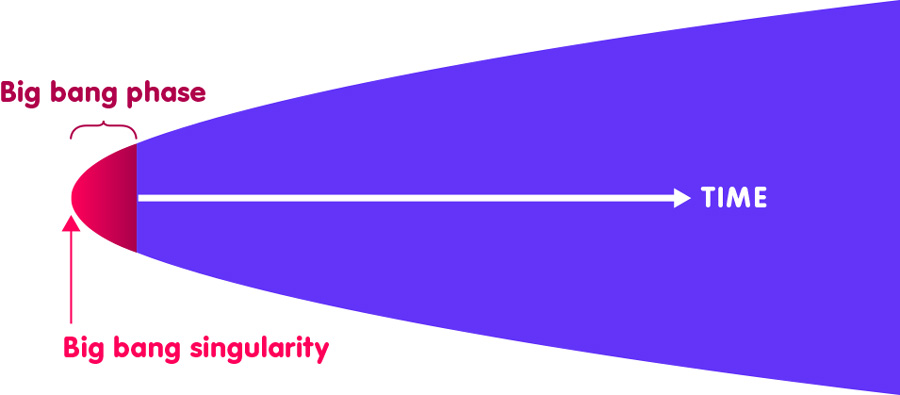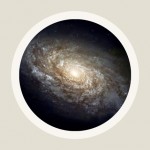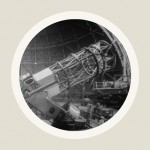A tale of two big bangs
In cosmology, “big bang” has two different meanings – and if you want to understand what’s going on, you should be aware of that difference.
An article by Markus Pössel
Whenever you hear or read about cosmology, there is one distinction you should have in the back of your mind – otherwise, matters might get a bit confusing: The term “big bang” has two slightly different meanings, and the answer to questions like “Did the big bang really happen” depends crucially on which of the two big bangs you are talking about.
Back to the beginning
The universe is expanding: The distance between far-away regions of space (for instance, between our galaxy and distant galaxy clusters) is steadily increasing with time. Accordingly, if we travel back in time, we will reach periods of cosmic history in which the galaxies were much closer together than they are today. Roughly 14 billion years ago, our voyage into the past leads us to a universe in which there were no individual galaxies, or even stars. The whole cosmos was filled with a homogeneous mixture of different types of matter particles and electromagnetic radiation. Quite generally, if you let a gas expand, it will cool down; if you compress it, it will heat up. Analogously, the temperature of the universe was significantly higher in the past. Going back, we will eventually reach times when the universe was thousands or millions of degrees hot and, beyond that, even hotter.
If we simply follow the predictions of Einstein’s theory of general relativity for the evolution of a simple expanding, homogeneous universe filled with matter and radiation, then our journey into the past will eventually come to an end – a point in time where we cannot go back any further. At this moment, all the galaxies that we see around us today were compressed into a region of zero volume – to a single point in space. Since density is defined as mass divided by volume, the density was infinite. In Einstein’s theory, matter influences the way that the geometry of space and time is distorted, and at this moment of infinite matter density, the curvature of spacetime was infinite, as well. Within the simple cosmological models based on general relativity, there is no possibility to go to any earlier times than this. Such a boundary of time (or, more generally, of spacetime) is called a singularity.
Big bang singularity and “big bang phase”
Now that we have followed the evolution of the universe as far as the simple models would let us, let us take stock: In those models, the beginning of the universe is a singularity which is commonly called the “big bang singularity” or simply the “big bang”. Directly afterwards, there followed a period of expansion during which the temperature and density of matter in the universe were so extreme that current science cannot tell us what happened – we simply do not have reliable physical theories describing the properties of matter under such extreme condition.
A mere millionth of a second later, we are back to normal – at least as far as high-energy physicists are concerned: Matter at such densities and temperatures can be produced in today’s most powerful particle accelerators, and this part of cosmic evolution can be described using a combination of the standard model of particle physics and general relativity. A few seconds later, we enter the period of Big Bang Nucleosynthesis, in which the first light elements such as helium are produced. Another 380,000 years later, the universe had cooled sufficiently to allow the formation of the first stable atoms. Over the next 14 or so billion years, the universe cools down ever further, stars and galaxies form, and eventually, on a planet close to a wholly unremarkable star, there evolves a species of intensely curious ape, whose representatives eventually take on the gargantuan task of trying to reconstruct what went on before.
And there we have them, the two senses in which the expression “big bang” is used, as sketched in the following illustration (not to scale), where time passes as you go from left to right, and where the expanding size of the universe is represented by an increase in vertical extent:

Sometimes, “big bang” stands for “big bang singularity” – the singular point in time that, according to the simple cosmological models, was the beginning of our universe. On other occasions, “big bang” encompasses the first minutes, or even the first 380,000 years of our universe’s early history – a whole “big bang phase”, if you will (though this is not a term that is commonly used). Often, the big bang phase is taken to include a hypothetical period of rapid, accelerated expansion called inflation, which began as early as 10-43 seconds after the big bang singularity.
Compared with the age of the universe, the difference between the two meanings is tiny – like arguing whether or not the tip of a 30 inch ruler includes the first hundredth of a millimetre of the ruler’s length. Yet tiny as it may be, there are occasions on which the difference becomes important. Here are two examples.
Which is which?
Did the big bang really happen? If you are talking about the big bang phase, the hot early universe as described by well-known physical theories (or, if you include inflation, by extrapolation from those theories), then there is good evidence that, yes, nearly 14 billion years ago, the cosmos developed in just the way described by the cosmological models (the main exhibits are the original abundances of light elements as deduced from astronomical observation, the distribution of far-away galaxies and the existence and properties of the so-called cosmic background radiation).
Whether or not there really was a big bang singularity is a totally different question. Most cosmologists would be very surprised if it turned out that our universe really did have an infinitely dense, infinitely hot, infinitely curved beginning. Commonly, the fact that a model predicts infinite values for some physical quantity indicates that the model is too simple and fails to include some crucial aspect of the real world. In fact, we already know what the usual cosmological models fail to include: At ultra-high densities, with the whole of the observable universe squeezed into a volume much smaller than that of an atom, we would expect quantum effects to become crucially important. But the cosmological standard models do not include full quantum versions of space, time and geometry – they are not based on a quantum theory of gravity. However, at the present time we do not yet have a reliable theory of quantum gravity. While there are promising candidates for such a theory, none are developed far enough to yield reliable predictions for the very early universe.
Thus, while some cosmologists do not have a problem with assuming that our universe began in a singular state, most are convinced that the big bang singularity is an artefact – to be replaced by a more accurate description once quantum gravity research has made suitable progress. To be replaced with what? Nobody knows for sure. In some models, we can go infinitely far into the past (one example is presented in the spotlight text Avoiding the big bang). In others, the big bang is replaced by a beginning of the universe which avoids all infinities, but in which time itself is rather different from what we are used to (some more information about this can be found in the spotlight text Searching for the quantum beginning of the universe).
On the other hand, whenever cosmologists talk about something happening a second, a minute, or 400,000 years after the big bang, their reference point is indeed the big bang singularity. The reason is that, in the cosmological models based on general relativity, the formulae for the expansion of the universe become particularly simple if you define t=0, cosmic time zero, to coincide with the big bang singularity. This is a great advantage for physics calculations dealing with the early universe, so defining cosmic time in this way makes good sense.
Still, there is a potential for confusion. Anyone not familiar with the conventions of cosmology might assume that the use of a phrase like “one hundredth of a second after the big bang” implies that, in the opinion of the writer or speaker, there really was a big bang singularity. Not so: Such a phrase is merely shorthand for “at a cosmic time of one hundredth of a second, where cosmic time is defined in a way that makes the physics of the early universe especially simple”.
Further Information
For the basic concepts of relativity of interest for this spotlight topic, check out Elementary Einstein, in particular the chapters Relativity and the quantum and Cosmology.
More information about singularities is contained in the spotlight text Spacetime singularities. Some answers to the question what, if not a big bang singularity, happened at cosmic time zero are given in Avoiding the big bang and in Searching for the quantum beginning of the universe. Other related Spotlights on relativity on Einstein-Online can be found in the sections Relativity and the quantum and Cosmology.
Colophon
is the managing scientist at Haus der Astronomie, the Center for Astronomy Education and Outreach in Heidelberg, and senior outreach scientist at the Max Planck Institute for Astronomy. He initiated Einstein Online.
Citation
Cite this article as:
Markus Pössel, “A tale of two big bangs” in: Einstein Online Band 04 (2010), 02-1015










